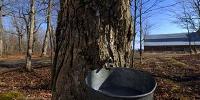© 2007 Jean Berthélémé, All Rights Reserved.
At Rocky Mountain Maples, sap is collected in the traditional way, in a bucket attached to a small metal tube inserted into the trunk of the tree. Maple trees, in particular a variety called sugar maple, have a sweet tasting sap which can be concentrated by boiling. Almost every day, large containers of sap are heated by wood-fired stoves. The result is a very sweet syrup which can then be further transformed into hard candy and hard or soft cream.
Approximately 40 litres of sap are required to produce one litre of maple syrup (one litre = .26 US gallon). A mature sugar maple tree can produce about 40 litres of sap during the 4-5 week season; only trees with a diameter of about 25 centimetres (10 inches) are tapped.
Canada produces more than 80% of the world's maple syrup; most of the production is concentrated in the provinces of Quebec, Ontario and New Brunswick. A handful of north-eastern US states also produce maple products.
USA-Canada / Canada-New Brunswick
Lat: 46° 10' 5.16" N
Long: 65° 52' 42.84" W
Precision is: Unknown / Undeclared.



 Tap or click the zoom icon in the bottom right corner of the picture to switch between in-page and fullscreen view
Tap or click the zoom icon in the bottom right corner of the picture to switch between in-page and fullscreen view